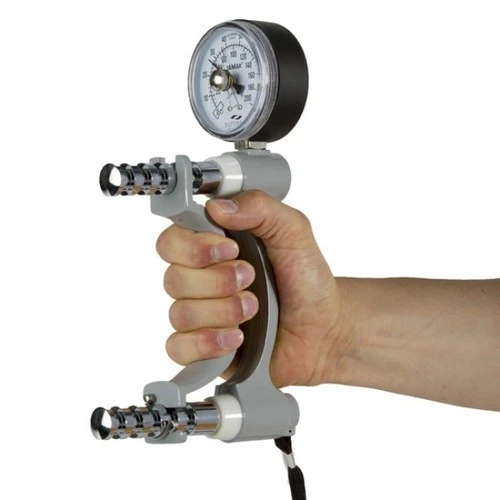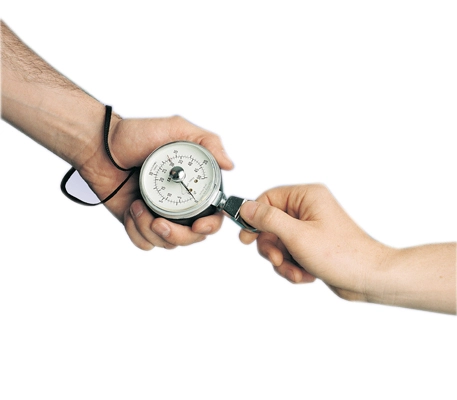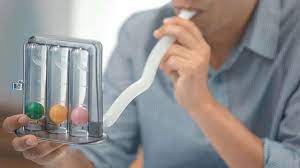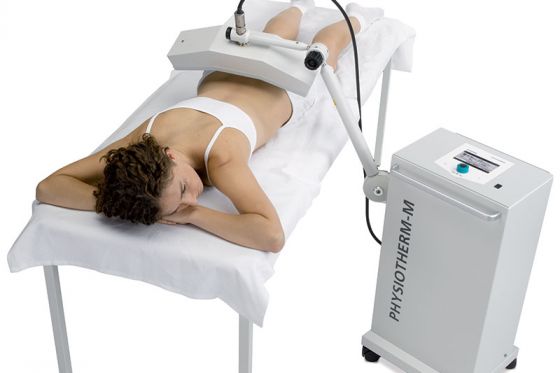Dynamometer
Table of Contents
Introduction
A dynamometer is a device used in physiotherapy to measure muscle strength and function. It is commonly used in manual muscle testing to assess the strength of various muscle groups in the body, including the neck.
Parts of dynamometers
A dynamometer consists of a handle or grip that the patient holds onto, and a gauge or digital display that measures the amount of force the patient is able to generate.
The healthcare professional can adjust the resistance on the dynamometer to provide varying levels of resistance for the patient to push or pull against.
Types of dynamometer

Dynamometers come in many different forms, including handheld devices, isokinetic machines, and cable systems. Each type has its own advantages and disadvantages, depending on the specific needs of the patient and the goals of the therapist.
Handheld Dynamometer:
This is a portable device that can be held in one hand and used to measure grip strength. It typically consists of a handle with a spring-loaded gauge that measures the amount of force being applied.
Hydraulic Dynamometer:
This type of dynamometer uses hydraulic pressure to measure muscle strength. The patient grips a handle attached to a hydraulic cylinder, and the pressure generated by their muscles is measured and displayed on a gauge.
Electronic Dynamometer:
This type of dynamometer uses electronic sensors to measure muscle strength. The patient grips a handle or sensor pad, and the force generated by their muscles is measured and displayed on a digital screen.

Pinch Gauge Dynamometer:
This type of dynamometer is specifically designed to measure pinch strength in the fingers and thumb. It consists of two plates that are squeezed together by the patient’s fingers, and the amount of force generated is measured and displayed on a gauge.
Isokinetic Dynamometer:
This type of dynamometer is used to measure muscle strength and function through a range of motion. The patient performs a specific movement, such as knee extension or shoulder rotation, while the dynamometer measures the amount of force being generated at each point in the movement.
Use of dynamometer
Dynamometers are commonly used in physiotherapy, sports medicine, and rehabilitation settings to examine muscle strength and function. They are also used in research studies to evaluate the effects of interventions on muscle power and performance.
- Handheld dynamometers are often used to measure grip strength, which is important for activities of daily living such as opening jars or carrying groceries. The patient holds the dynamometer in their hand and squeezes the handle as hard as they can. The force generated is measured and recorded.
- Hydraulic and electronic dynamometers are more advanced devices that can measure muscle strength in a variety of movements and positions. They can provide more accurate and precise measurements than handheld dynamometers. These types of dynamometers are often used in research studies to evaluate changes in muscle strength over time or in response to different interventions.
- Pinch gauge dynamometers are specifically designed to measure pinch strength, which is important for activities such as writing or gripping objects. The patient places their fingers between two plates and squeezes them together as hard as they can. The force generated is measured and recorded.
- Isokinetic dynamometers are typically used in sports medicine settings to assess muscle strength and function in athletes. The patient performs a specific movement, such as knee extension or shoulder rotation, while the dynamometer measures the amount of force being generated at each point in the movement. This can help identify areas of weakness or imbalance that may need to be addressed through targeted exercise or rehabilitation programs.
Overall, dynamometers are valuable tools for assessing muscle strength and function in a variety of settings. They can provide objective measurements that can help guide treatment decisions and track progress over time.
Types of Dynamometers test
There are several variations of the hand dynamometer test that can be used to assess different aspects of muscle strength and function.
Maximum Voluntary Contraction (MVC) Test: This test is used to measure the maximum amount of force a patient can generate with their muscles. The patient is asked to grip the dynamometer as tightly as possible for a few seconds while the healthcare professional records the reading. This test is useful for assessing overall muscle strength and for tracking changes over time.
Rapid Exchange Test: This test is used to assess how quickly a patient can generate force with their muscles. The patient is asked to grip and release the dynamometer as quickly as possible for a set amount of time, while the healthcare professional records the readings. This test is useful for assessing muscle endurance and for identifying any weaknesses or imbalances in muscle function.
Fatigue Test: This test is used to assess how quickly a patient’s muscles fatigue during sustained activity. The patient is asked to grip the dynamometer at a certain percentage of their maximum grip strength for a set amount of time, while the healthcare professional records the readings. This test is useful for identifying any muscle weaknesses or imbalances in muscle function that may contribute to fatigue or pain.
Pinch Strength Test: This test assesses grip strength specifically in the fingers and thumb. The patient is asked to pinch the dynamometer between their fingers and thumb as tightly as possible for a few seconds, while the healthcare professional records the reading. This test is useful for assessing hand and wrist function, and for identifying any weaknesses or imbalances in grip strength.
Three-Finger Pinch Test: This test is used to assess grip strength specifically in the index, middle, and ring fingers. The patient is asked to pinch the dynamometer between these three fingers as tightly as possible for a few seconds, while the healthcare professional records the reading. This test is useful for assessing hand and wrist function, and for identifying any weaknesses or imbalances in grip strength.
How to perform the test?
To test strength with a dynamometer, follow these steps:
- Choose the appropriate type of dynamometer for the muscle group being tested and the desired level of accuracy.
- Explain the testing procedure to the patient and ensure they are in a comfortable position.
- Calibrate the dynamometer according to the manufacturer’s instructions.
- Instruct the patient to perform the desired movement or grip as hard as they can for a few seconds.
- Record the force the patient generates on the dynamometer display or through connected software.
- Repeat the test several times to ensure consistency and accuracy of results.
- Compare the results to normative data or previous measurements to assess changes in muscle strength over time.
- Use the results to guide treatment decisions and develop targeted exercise or rehabilitation programs.
It is important to note that proper technique and positioning are crucial for accurate and reliable results when using a dynamometer. It is also important to consider factors such as age, gender, and body composition when interpreting results. A trained healthcare professional should always administer and interpret dynamometry tests.
In Which condition dynamometer can be used?
Dynamometers can be used in a variety of conditions to assess muscle strength and function. Some common conditions where dynamometry may be used include:
Rehabilitation after surgery or injury: Dynamometry can help assess the progress of rehabilitation and guide the development of targeted exercise programs to improve muscle strength and function.
Neurological conditions: Dynamometry can be used to assess muscle weakness and spasticity in conditions such as stroke, multiple sclerosis, and Parkinson’s disease.
Sports medicine: Dynamometry can be used to assess muscle strength and power in athletes, as well as to monitor changes in strength over time.
Occupational medicine: Dynamometry can be used to assess the physical demands of a job and determine if an individual is fit for duty.
Geriatrics: Dynamometry can be used to assess muscle weakness and frailty in older adults, as well as to monitor changes in strength over time.
Overall, dynamometry can be a valuable tool in assessing muscle strength and function in a variety of conditions and can help guide treatment decisions and rehabilitation programs.
Advantages
- Objective Measurements: Dynamometers provide objective measurements of muscle strength, which can help therapists create more effective treatment plans. These measurements are more accurate and reliable than subjective assessments by the therapist, which can be influenced by personal bias or interpretation.
- Tracking Progress: Dynamometers can be used to track progress over time, allowing therapists to evaluate the effectiveness of treatment and make adjustments as necessary. This can provide motivation for patients, who can see their improvement and feel a sense of accomplishment.
- Individualized Treatment: Dynamometers can help therapists identify specific areas of weakness or imbalance, allowing them to develop individualized treatment plans that target these areas. This can improve the overall effectiveness of treatment and lead to better outcomes for patients.
- Research: Dynamometers are commonly used in research studies to measure muscle strength and function. This research can help inform best practices in physiotherapy and improve patient outcomes.
- Standardization: Dynamometers provide standardized testing procedures, which can help ensure consistency in testing across different therapists and clinics. This can improve the reliability and validity of test results.
Overall, dynamometers are a valuable tool in physiotherapy that can provide objective measurements, track progress, and inform individualized treatment plans. While there are potential disadvantages and risks associated with their use, these can be mitigated with proper training and monitoring by therapists.
Disadvantages
While dynamometers have many advantages in physiotherapy, there are also some potential disadvantages to consider:
Cost: Depending on the type and quality of the dynamometer, it can be quite expensive to purchase and maintain. This may limit their availability in some clinics or for some patients.
Limited range of motion: Some types of dynamometers, such as handheld devices, may only be able to measure strength in a limited range of motion. This may not provide a complete picture of the patient’s functional abilities.
Patient discomfort: Depending on the type of testing being done, patients may experience discomfort or pain during the testing process. This can be particularly true for isokinetic testing, which involves high levels of resistance and rapid movements.
Lack of specificity: While dynamometers can provide valuable information about overall muscle strength, they may not be able to identify specific weaknesses or imbalances, in the same way, that functional movement assessment can.
Reliance on equipment: Dynamometers require specialized equipment to use, which means that therapists may not be able to assess muscle strength and function in the same way if the equipment is unavailable or malfunctioning.
Overall, while dynamometers can be a valuable tool in physiotherapy, it is important to carefully consider their limitations and potential drawbacks before relying on them as the sole method of assessment and treatment planning.
Precautions
While dynamometers are a useful tool for assessing muscle strength and function, there are some precautions that should be taken to ensure proper and safe use:
Calibration: It is important to calibrate the dynamometer regularly to ensure accurate readings. This can be done using a calibration weight or by following the manufacturer’s instructions.
Positioning: Proper positioning of the individual being tested is important to ensure accurate readings. The individual should be seated comfortably with their back supported and their feet flat on the ground. The dynamometer should be placed in a position that allows for a comfortable grip and proper alignment of the joint being tested.
Warm-up: A proper warm-up should be performed before testing to ensure accurate results. This can include light active exercise and easy stretching.
Fatigue: It is important to avoid testing muscles that are fatigued, as this can lead to inaccurate results. Rest periods should be provided between tests to allow for muscle recovery.
Safety: It is important to follow safety guidelines when using a dynamometer. This includes ensuring that the dynamometer is in good working condition, avoiding excessive force during testing, and monitoring for signs of discomfort or pain during testing.
Overall, proper use of a dynamometer can provide valuable information about muscle strength and function, but it is important to take precautions to ensure accurate and safe testing.
Summary
A dynamometer is a tool used to assess muscle strength and function. To ensure accurate and safe use, it is important to calibrate the dynamometer regularly, position the individual being tested properly, perform a proper warm-up, avoid testing fatigued muscles, and follow safety guidelines. Adequate use of a dynamometer can provide valuable information about muscle strength and function.
FAQ
Yes, dynamometers can be used to measure muscle strength in any part of the body, depending on the type of dynamometer being used.
While there is generally low risk associated with using a dynamometer, patients may experience discomfort or pain during testing. Therapists should carefully monitor patients during testing to ensure their safety and comfort.






One Comment